Analysis of Determinants of IT Outsourcing Services in Australia
VerifiedAdded on 2020/04/01
|17
|3215
|40
Report
AI Summary
This report examines the determinants of IT outsourcing services within an Australian IT company, aiming to understand the factors influencing outsourcing decisions. It begins with an introduction to outsourcing, highlighting its significance in the globalized Australian economy and the substantial investment in IT by the government. The project objective is to identify the specific determinants, exploring both total and selective outsourcing strategies. The literature review covers key concepts like IT and IS, definitions of outsourcing, and the differences between onshore, nearshore, and offshore outsourcing. The research proposes five hypotheses, focusing on cost motivation, performance improvement, IT department size, management involvement, and IT-intensive sectors. The methodology includes both qualitative (interviews) and quantitative (questionnaires) research methods, detailing data analysis and research limitations. The report concludes by emphasizing the importance of understanding the reasons behind IT outsourcing decisions, particularly in the context of Australian IT companies, and suggests that the findings could indicate the determinants of total and selective outsourcing and the reasons for them.
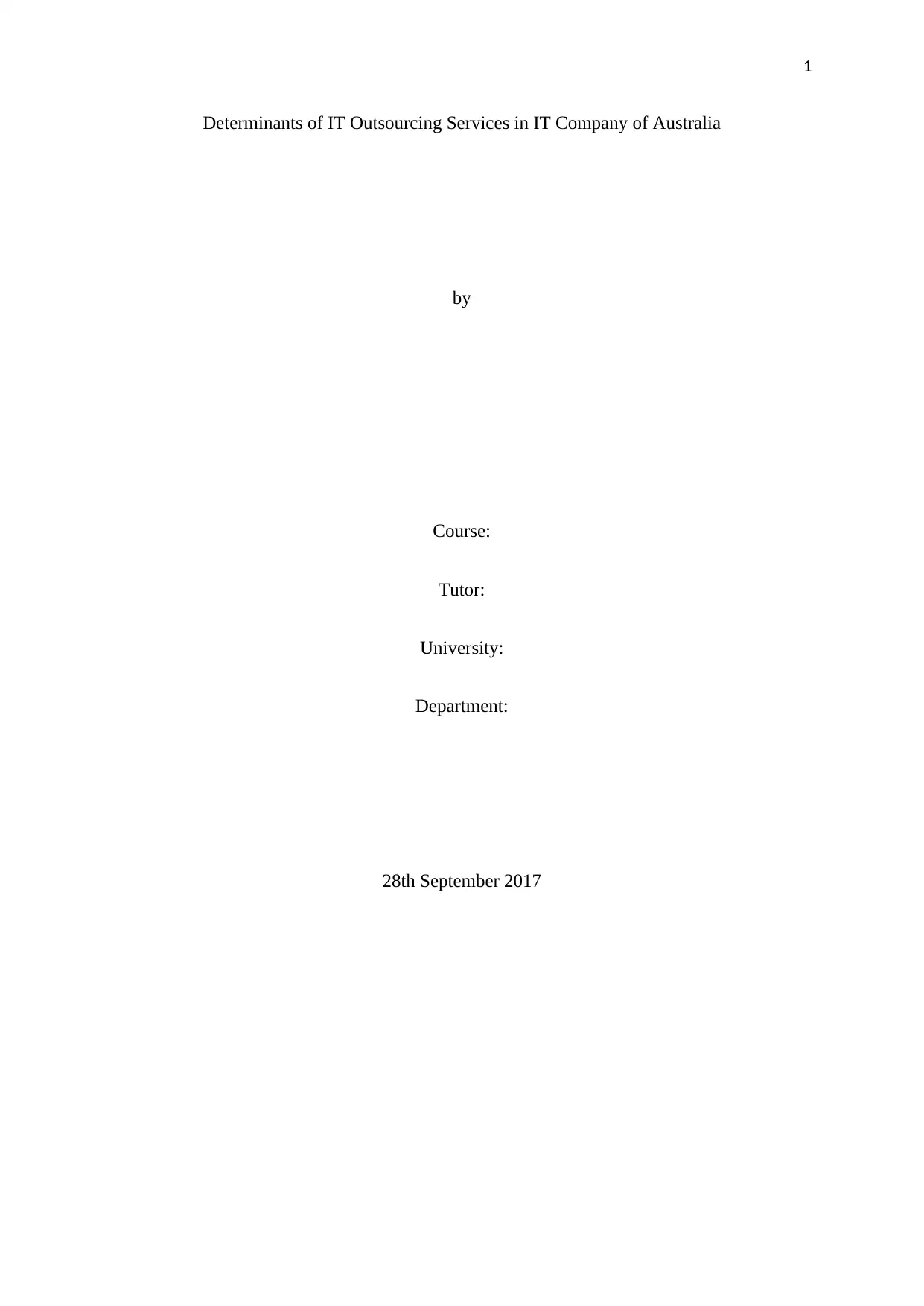
1
Determinants of IT Outsourcing Services in IT Company of Australia
by
Course:
Tutor:
University:
Department:
28th September 2017
Determinants of IT Outsourcing Services in IT Company of Australia
by
Course:
Tutor:
University:
Department:
28th September 2017
Paraphrase This Document
Need a fresh take? Get an instant paraphrase of this document with our AI Paraphraser
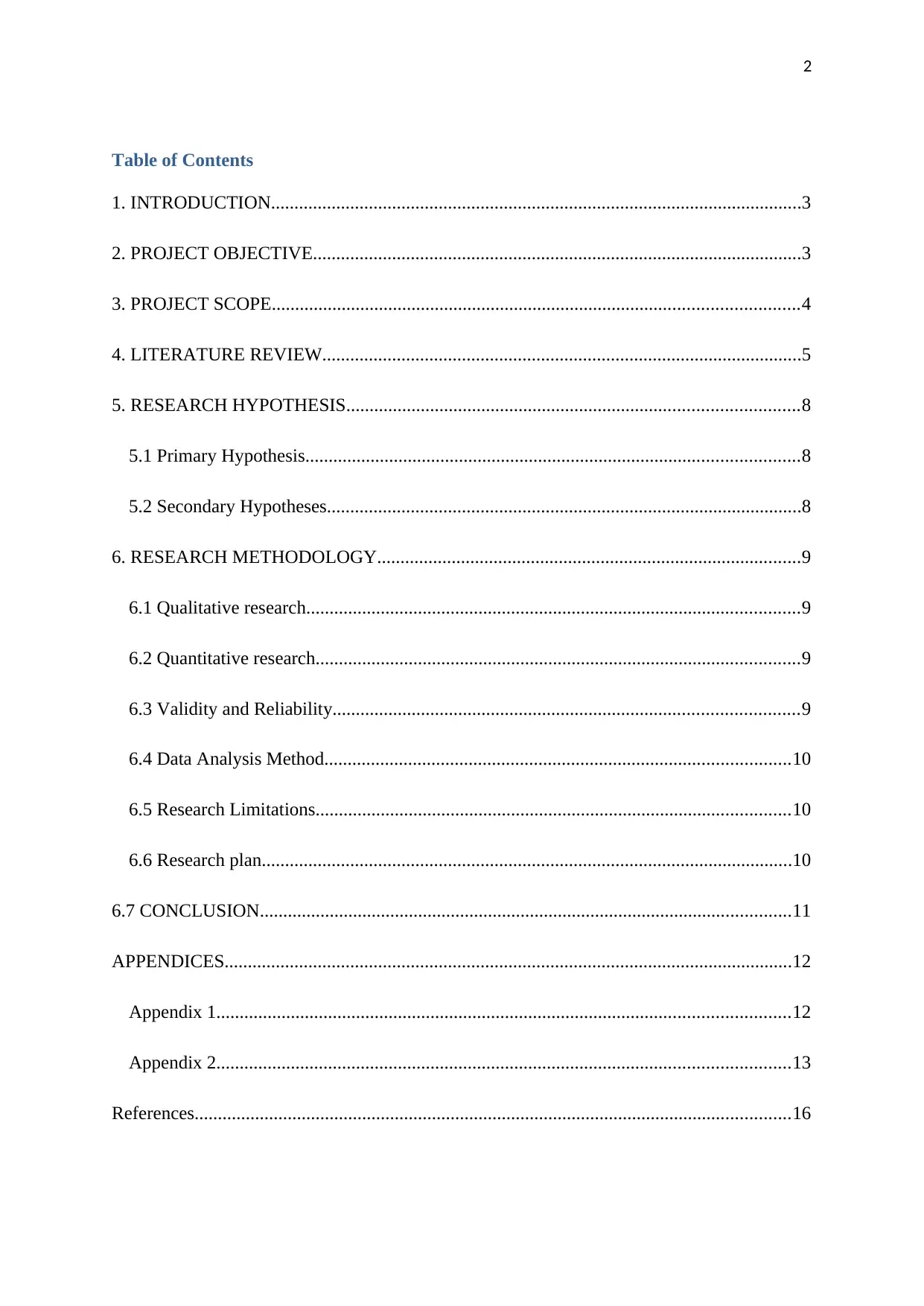
2
Table of Contents
1. INTRODUCTION..................................................................................................................3
2. PROJECT OBJECTIVE.........................................................................................................3
3. PROJECT SCOPE.................................................................................................................4
4. LITERATURE REVIEW.......................................................................................................5
5. RESEARCH HYPOTHESIS.................................................................................................8
5.1 Primary Hypothesis..........................................................................................................8
5.2 Secondary Hypotheses......................................................................................................8
6. RESEARCH METHODOLOGY...........................................................................................9
6.1 Qualitative research..........................................................................................................9
6.2 Quantitative research........................................................................................................9
6.3 Validity and Reliability....................................................................................................9
6.4 Data Analysis Method....................................................................................................10
6.5 Research Limitations......................................................................................................10
6.6 Research plan..................................................................................................................10
6.7 CONCLUSION..................................................................................................................11
APPENDICES..........................................................................................................................12
Appendix 1...........................................................................................................................12
Appendix 2...........................................................................................................................13
References................................................................................................................................16
Table of Contents
1. INTRODUCTION..................................................................................................................3
2. PROJECT OBJECTIVE.........................................................................................................3
3. PROJECT SCOPE.................................................................................................................4
4. LITERATURE REVIEW.......................................................................................................5
5. RESEARCH HYPOTHESIS.................................................................................................8
5.1 Primary Hypothesis..........................................................................................................8
5.2 Secondary Hypotheses......................................................................................................8
6. RESEARCH METHODOLOGY...........................................................................................9
6.1 Qualitative research..........................................................................................................9
6.2 Quantitative research........................................................................................................9
6.3 Validity and Reliability....................................................................................................9
6.4 Data Analysis Method....................................................................................................10
6.5 Research Limitations......................................................................................................10
6.6 Research plan..................................................................................................................10
6.7 CONCLUSION..................................................................................................................11
APPENDICES..........................................................................................................................12
Appendix 1...........................................................................................................................12
Appendix 2...........................................................................................................................13
References................................................................................................................................16
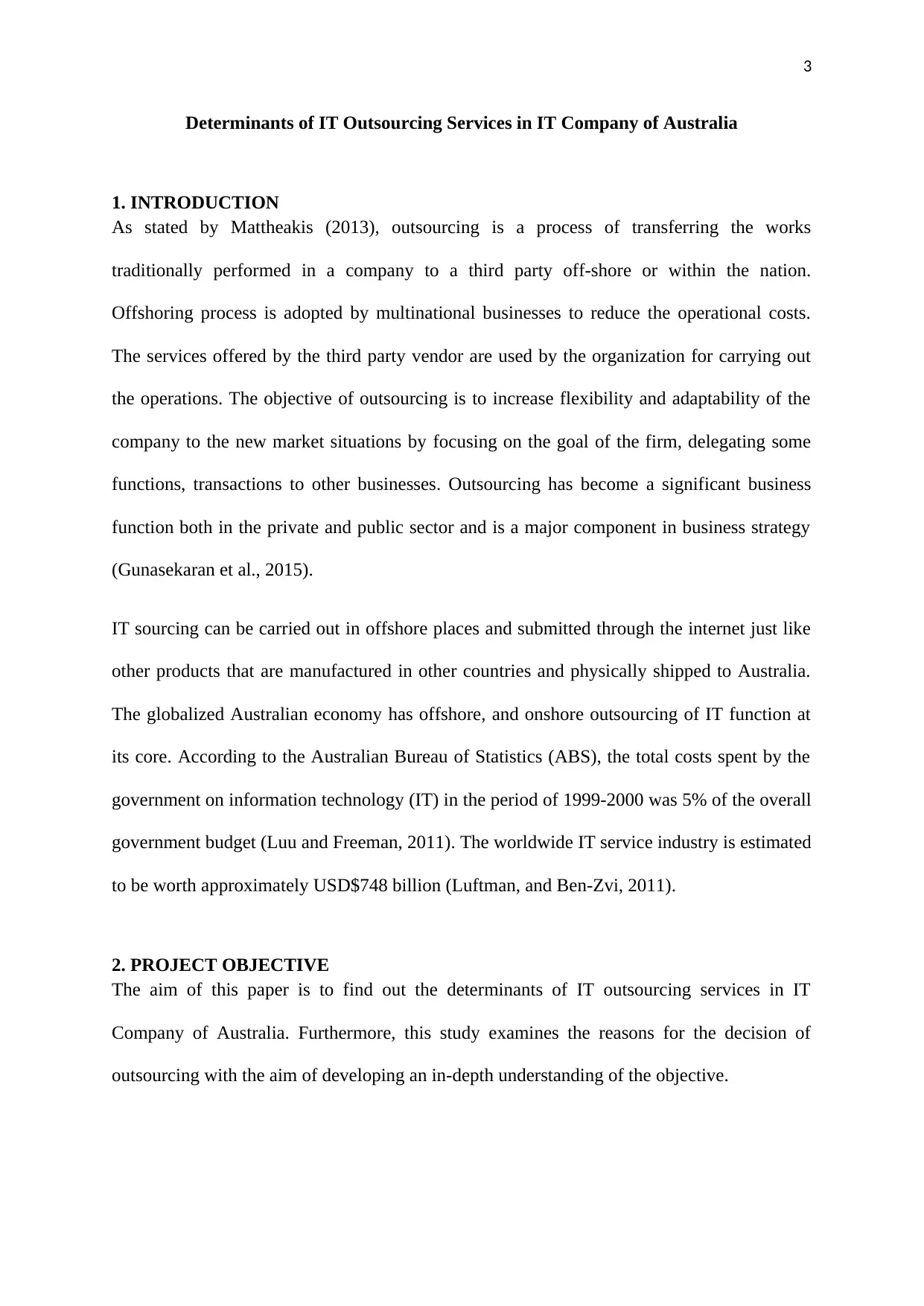
3
Determinants of IT Outsourcing Services in IT Company of Australia
1. INTRODUCTION
As stated by Mattheakis (2013), outsourcing is a process of transferring the works
traditionally performed in a company to a third party off-shore or within the nation.
Offshoring process is adopted by multinational businesses to reduce the operational costs.
The services offered by the third party vendor are used by the organization for carrying out
the operations. The objective of outsourcing is to increase flexibility and adaptability of the
company to the new market situations by focusing on the goal of the firm, delegating some
functions, transactions to other businesses. Outsourcing has become a significant business
function both in the private and public sector and is a major component in business strategy
(Gunasekaran et al., 2015).
IT sourcing can be carried out in offshore places and submitted through the internet just like
other products that are manufactured in other countries and physically shipped to Australia.
The globalized Australian economy has offshore, and onshore outsourcing of IT function at
its core. According to the Australian Bureau of Statistics (ABS), the total costs spent by the
government on information technology (IT) in the period of 1999-2000 was 5% of the overall
government budget (Luu and Freeman, 2011). The worldwide IT service industry is estimated
to be worth approximately USD$748 billion (Luftman, and Ben-Zvi, 2011).
2. PROJECT OBJECTIVE
The aim of this paper is to find out the determinants of IT outsourcing services in IT
Company of Australia. Furthermore, this study examines the reasons for the decision of
outsourcing with the aim of developing an in-depth understanding of the objective.
Determinants of IT Outsourcing Services in IT Company of Australia
1. INTRODUCTION
As stated by Mattheakis (2013), outsourcing is a process of transferring the works
traditionally performed in a company to a third party off-shore or within the nation.
Offshoring process is adopted by multinational businesses to reduce the operational costs.
The services offered by the third party vendor are used by the organization for carrying out
the operations. The objective of outsourcing is to increase flexibility and adaptability of the
company to the new market situations by focusing on the goal of the firm, delegating some
functions, transactions to other businesses. Outsourcing has become a significant business
function both in the private and public sector and is a major component in business strategy
(Gunasekaran et al., 2015).
IT sourcing can be carried out in offshore places and submitted through the internet just like
other products that are manufactured in other countries and physically shipped to Australia.
The globalized Australian economy has offshore, and onshore outsourcing of IT function at
its core. According to the Australian Bureau of Statistics (ABS), the total costs spent by the
government on information technology (IT) in the period of 1999-2000 was 5% of the overall
government budget (Luu and Freeman, 2011). The worldwide IT service industry is estimated
to be worth approximately USD$748 billion (Luftman, and Ben-Zvi, 2011).
2. PROJECT OBJECTIVE
The aim of this paper is to find out the determinants of IT outsourcing services in IT
Company of Australia. Furthermore, this study examines the reasons for the decision of
outsourcing with the aim of developing an in-depth understanding of the objective.
⊘ This is a preview!⊘
Do you want full access?
Subscribe today to unlock all pages.

Trusted by 1+ million students worldwide
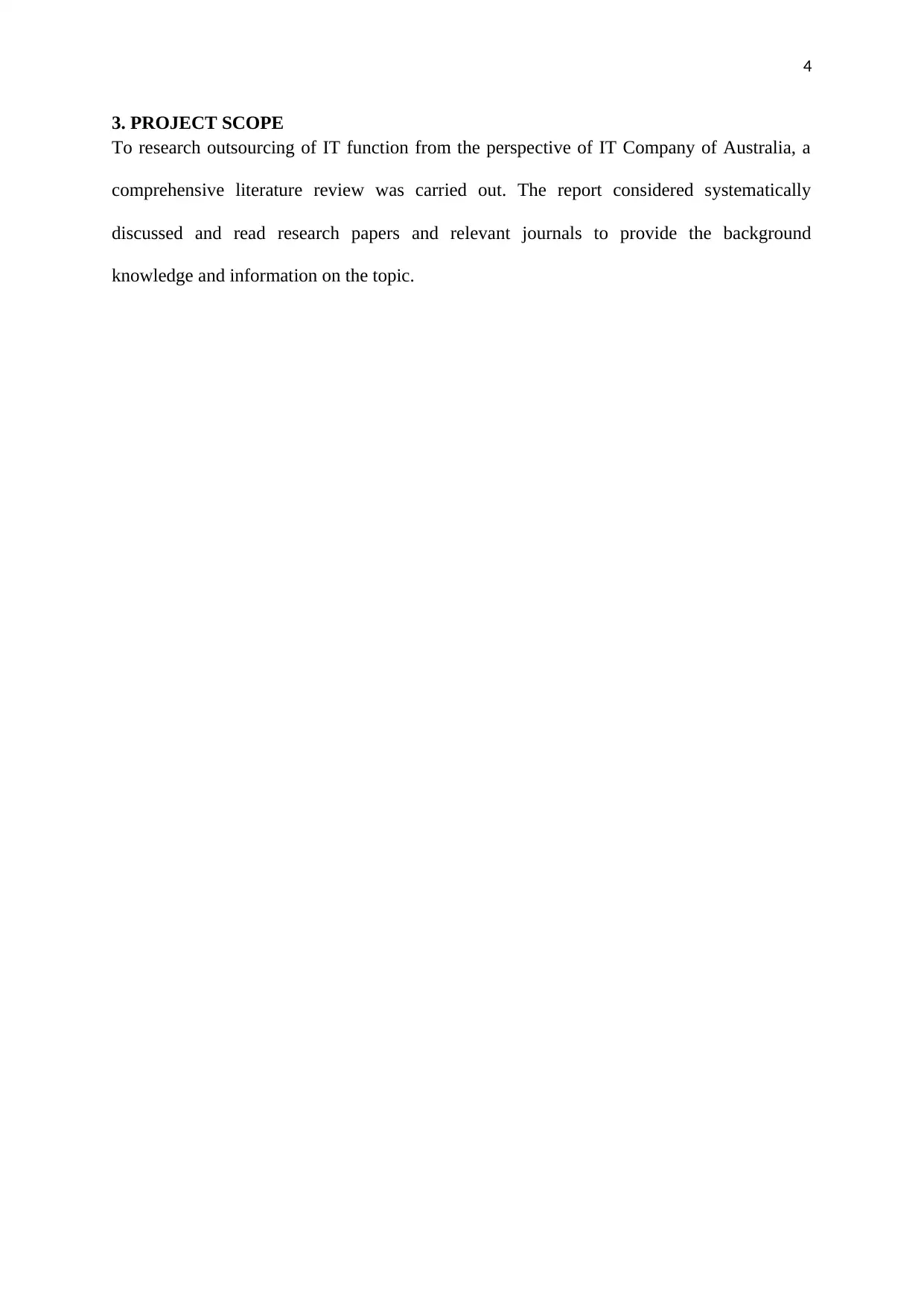
4
3. PROJECT SCOPE
To research outsourcing of IT function from the perspective of IT Company of Australia, a
comprehensive literature review was carried out. The report considered systematically
discussed and read research papers and relevant journals to provide the background
knowledge and information on the topic.
3. PROJECT SCOPE
To research outsourcing of IT function from the perspective of IT Company of Australia, a
comprehensive literature review was carried out. The report considered systematically
discussed and read research papers and relevant journals to provide the background
knowledge and information on the topic.
Paraphrase This Document
Need a fresh take? Get an instant paraphrase of this document with our AI Paraphraser
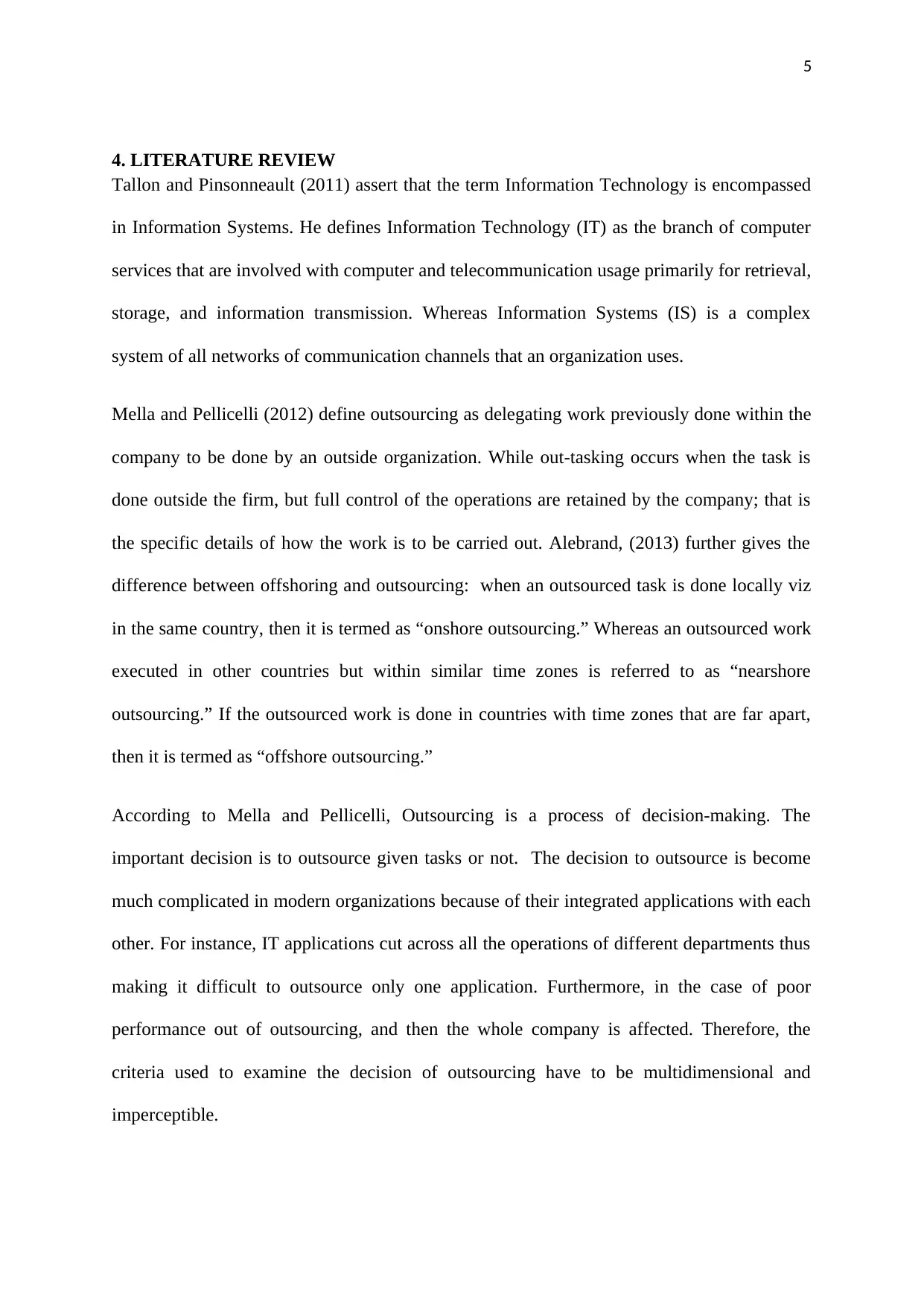
5
4. LITERATURE REVIEW
Tallon and Pinsonneault (2011) assert that the term Information Technology is encompassed
in Information Systems. He defines Information Technology (IT) as the branch of computer
services that are involved with computer and telecommunication usage primarily for retrieval,
storage, and information transmission. Whereas Information Systems (IS) is a complex
system of all networks of communication channels that an organization uses.
Mella and Pellicelli (2012) define outsourcing as delegating work previously done within the
company to be done by an outside organization. While out-tasking occurs when the task is
done outside the firm, but full control of the operations are retained by the company; that is
the specific details of how the work is to be carried out. Alebrand, (2013) further gives the
difference between offshoring and outsourcing: when an outsourced task is done locally viz
in the same country, then it is termed as “onshore outsourcing.” Whereas an outsourced work
executed in other countries but within similar time zones is referred to as “nearshore
outsourcing.” If the outsourced work is done in countries with time zones that are far apart,
then it is termed as “offshore outsourcing.”
According to Mella and Pellicelli, Outsourcing is a process of decision-making. The
important decision is to outsource given tasks or not. The decision to outsource is become
much complicated in modern organizations because of their integrated applications with each
other. For instance, IT applications cut across all the operations of different departments thus
making it difficult to outsource only one application. Furthermore, in the case of poor
performance out of outsourcing, and then the whole company is affected. Therefore, the
criteria used to examine the decision of outsourcing have to be multidimensional and
imperceptible.
4. LITERATURE REVIEW
Tallon and Pinsonneault (2011) assert that the term Information Technology is encompassed
in Information Systems. He defines Information Technology (IT) as the branch of computer
services that are involved with computer and telecommunication usage primarily for retrieval,
storage, and information transmission. Whereas Information Systems (IS) is a complex
system of all networks of communication channels that an organization uses.
Mella and Pellicelli (2012) define outsourcing as delegating work previously done within the
company to be done by an outside organization. While out-tasking occurs when the task is
done outside the firm, but full control of the operations are retained by the company; that is
the specific details of how the work is to be carried out. Alebrand, (2013) further gives the
difference between offshoring and outsourcing: when an outsourced task is done locally viz
in the same country, then it is termed as “onshore outsourcing.” Whereas an outsourced work
executed in other countries but within similar time zones is referred to as “nearshore
outsourcing.” If the outsourced work is done in countries with time zones that are far apart,
then it is termed as “offshore outsourcing.”
According to Mella and Pellicelli, Outsourcing is a process of decision-making. The
important decision is to outsource given tasks or not. The decision to outsource is become
much complicated in modern organizations because of their integrated applications with each
other. For instance, IT applications cut across all the operations of different departments thus
making it difficult to outsource only one application. Furthermore, in the case of poor
performance out of outsourcing, and then the whole company is affected. Therefore, the
criteria used to examine the decision of outsourcing have to be multidimensional and
imperceptible.
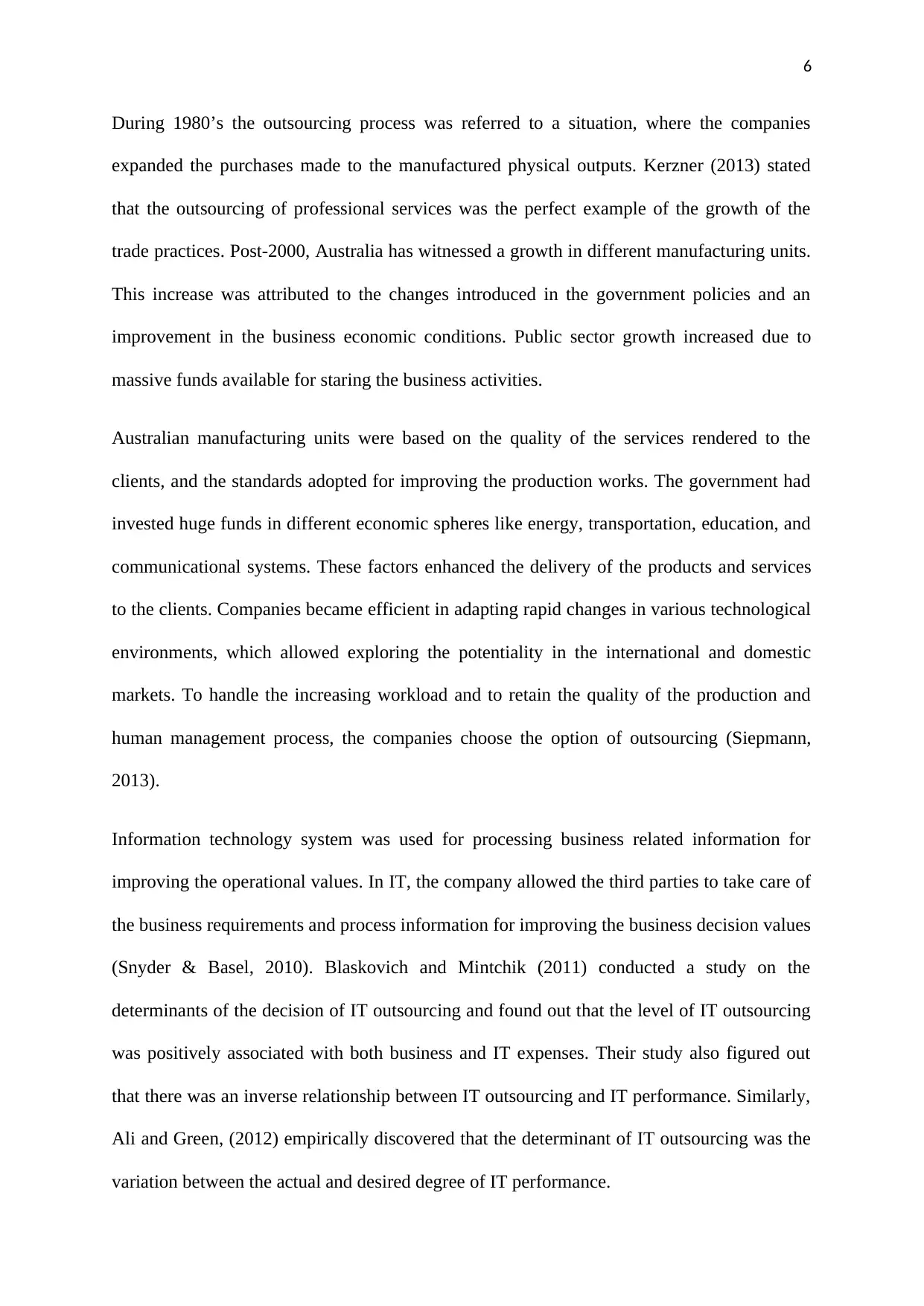
6
During 1980’s the outsourcing process was referred to a situation, where the companies
expanded the purchases made to the manufactured physical outputs. Kerzner (2013) stated
that the outsourcing of professional services was the perfect example of the growth of the
trade practices. Post-2000, Australia has witnessed a growth in different manufacturing units.
This increase was attributed to the changes introduced in the government policies and an
improvement in the business economic conditions. Public sector growth increased due to
massive funds available for staring the business activities.
Australian manufacturing units were based on the quality of the services rendered to the
clients, and the standards adopted for improving the production works. The government had
invested huge funds in different economic spheres like energy, transportation, education, and
communicational systems. These factors enhanced the delivery of the products and services
to the clients. Companies became efficient in adapting rapid changes in various technological
environments, which allowed exploring the potentiality in the international and domestic
markets. To handle the increasing workload and to retain the quality of the production and
human management process, the companies choose the option of outsourcing (Siepmann,
2013).
Information technology system was used for processing business related information for
improving the operational values. In IT, the company allowed the third parties to take care of
the business requirements and process information for improving the business decision values
(Snyder & Basel, 2010). Blaskovich and Mintchik (2011) conducted a study on the
determinants of the decision of IT outsourcing and found out that the level of IT outsourcing
was positively associated with both business and IT expenses. Their study also figured out
that there was an inverse relationship between IT outsourcing and IT performance. Similarly,
Ali and Green, (2012) empirically discovered that the determinant of IT outsourcing was the
variation between the actual and desired degree of IT performance.
During 1980’s the outsourcing process was referred to a situation, where the companies
expanded the purchases made to the manufactured physical outputs. Kerzner (2013) stated
that the outsourcing of professional services was the perfect example of the growth of the
trade practices. Post-2000, Australia has witnessed a growth in different manufacturing units.
This increase was attributed to the changes introduced in the government policies and an
improvement in the business economic conditions. Public sector growth increased due to
massive funds available for staring the business activities.
Australian manufacturing units were based on the quality of the services rendered to the
clients, and the standards adopted for improving the production works. The government had
invested huge funds in different economic spheres like energy, transportation, education, and
communicational systems. These factors enhanced the delivery of the products and services
to the clients. Companies became efficient in adapting rapid changes in various technological
environments, which allowed exploring the potentiality in the international and domestic
markets. To handle the increasing workload and to retain the quality of the production and
human management process, the companies choose the option of outsourcing (Siepmann,
2013).
Information technology system was used for processing business related information for
improving the operational values. In IT, the company allowed the third parties to take care of
the business requirements and process information for improving the business decision values
(Snyder & Basel, 2010). Blaskovich and Mintchik (2011) conducted a study on the
determinants of the decision of IT outsourcing and found out that the level of IT outsourcing
was positively associated with both business and IT expenses. Their study also figured out
that there was an inverse relationship between IT outsourcing and IT performance. Similarly,
Ali and Green, (2012) empirically discovered that the determinant of IT outsourcing was the
variation between the actual and desired degree of IT performance.
⊘ This is a preview!⊘
Do you want full access?
Subscribe today to unlock all pages.

Trusted by 1+ million students worldwide
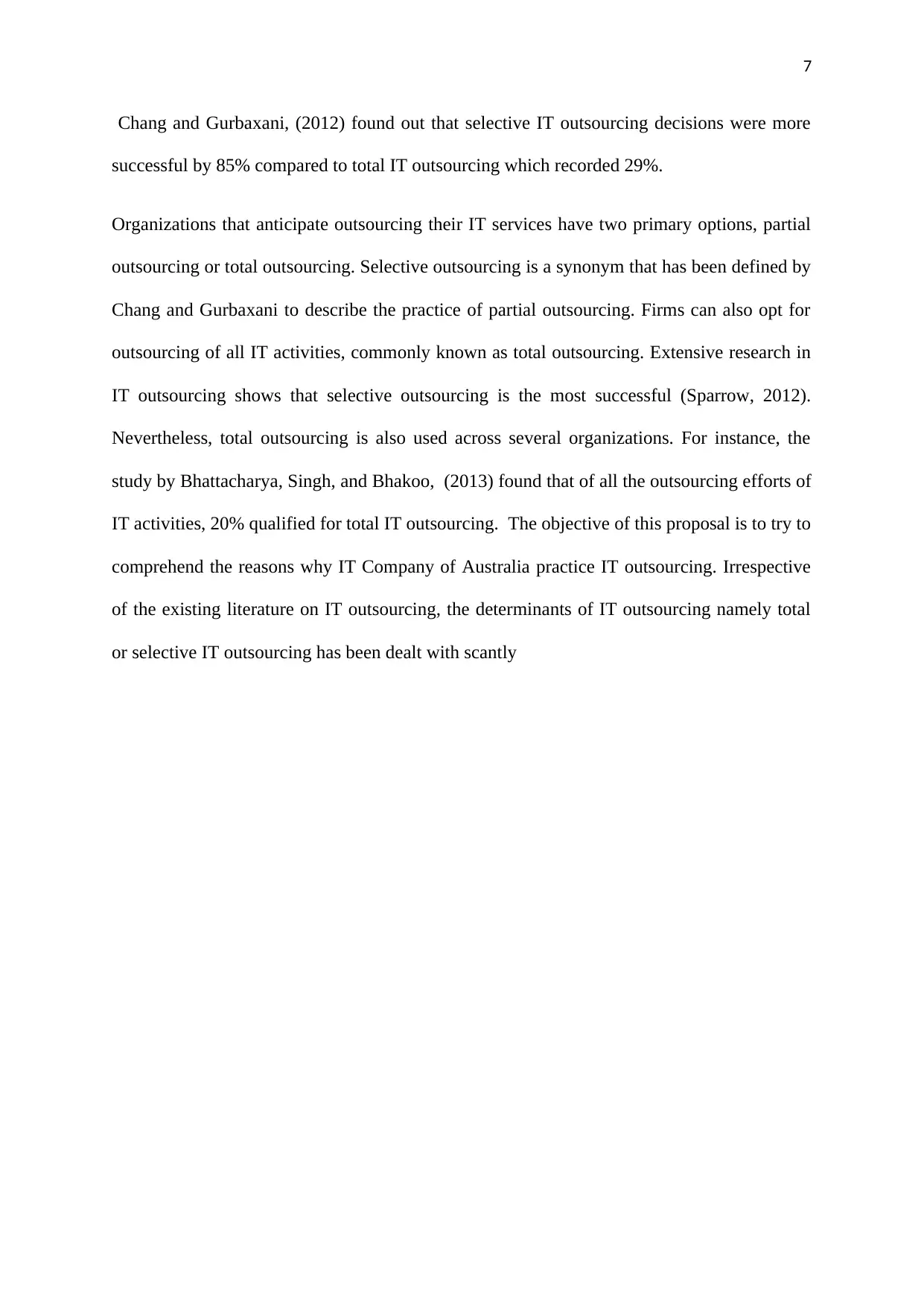
7
Chang and Gurbaxani, (2012) found out that selective IT outsourcing decisions were more
successful by 85% compared to total IT outsourcing which recorded 29%.
Organizations that anticipate outsourcing their IT services have two primary options, partial
outsourcing or total outsourcing. Selective outsourcing is a synonym that has been defined by
Chang and Gurbaxani to describe the practice of partial outsourcing. Firms can also opt for
outsourcing of all IT activities, commonly known as total outsourcing. Extensive research in
IT outsourcing shows that selective outsourcing is the most successful (Sparrow, 2012).
Nevertheless, total outsourcing is also used across several organizations. For instance, the
study by Bhattacharya, Singh, and Bhakoo, (2013) found that of all the outsourcing efforts of
IT activities, 20% qualified for total IT outsourcing. The objective of this proposal is to try to
comprehend the reasons why IT Company of Australia practice IT outsourcing. Irrespective
of the existing literature on IT outsourcing, the determinants of IT outsourcing namely total
or selective IT outsourcing has been dealt with scantly
Chang and Gurbaxani, (2012) found out that selective IT outsourcing decisions were more
successful by 85% compared to total IT outsourcing which recorded 29%.
Organizations that anticipate outsourcing their IT services have two primary options, partial
outsourcing or total outsourcing. Selective outsourcing is a synonym that has been defined by
Chang and Gurbaxani to describe the practice of partial outsourcing. Firms can also opt for
outsourcing of all IT activities, commonly known as total outsourcing. Extensive research in
IT outsourcing shows that selective outsourcing is the most successful (Sparrow, 2012).
Nevertheless, total outsourcing is also used across several organizations. For instance, the
study by Bhattacharya, Singh, and Bhakoo, (2013) found that of all the outsourcing efforts of
IT activities, 20% qualified for total IT outsourcing. The objective of this proposal is to try to
comprehend the reasons why IT Company of Australia practice IT outsourcing. Irrespective
of the existing literature on IT outsourcing, the determinants of IT outsourcing namely total
or selective IT outsourcing has been dealt with scantly
Paraphrase This Document
Need a fresh take? Get an instant paraphrase of this document with our AI Paraphraser
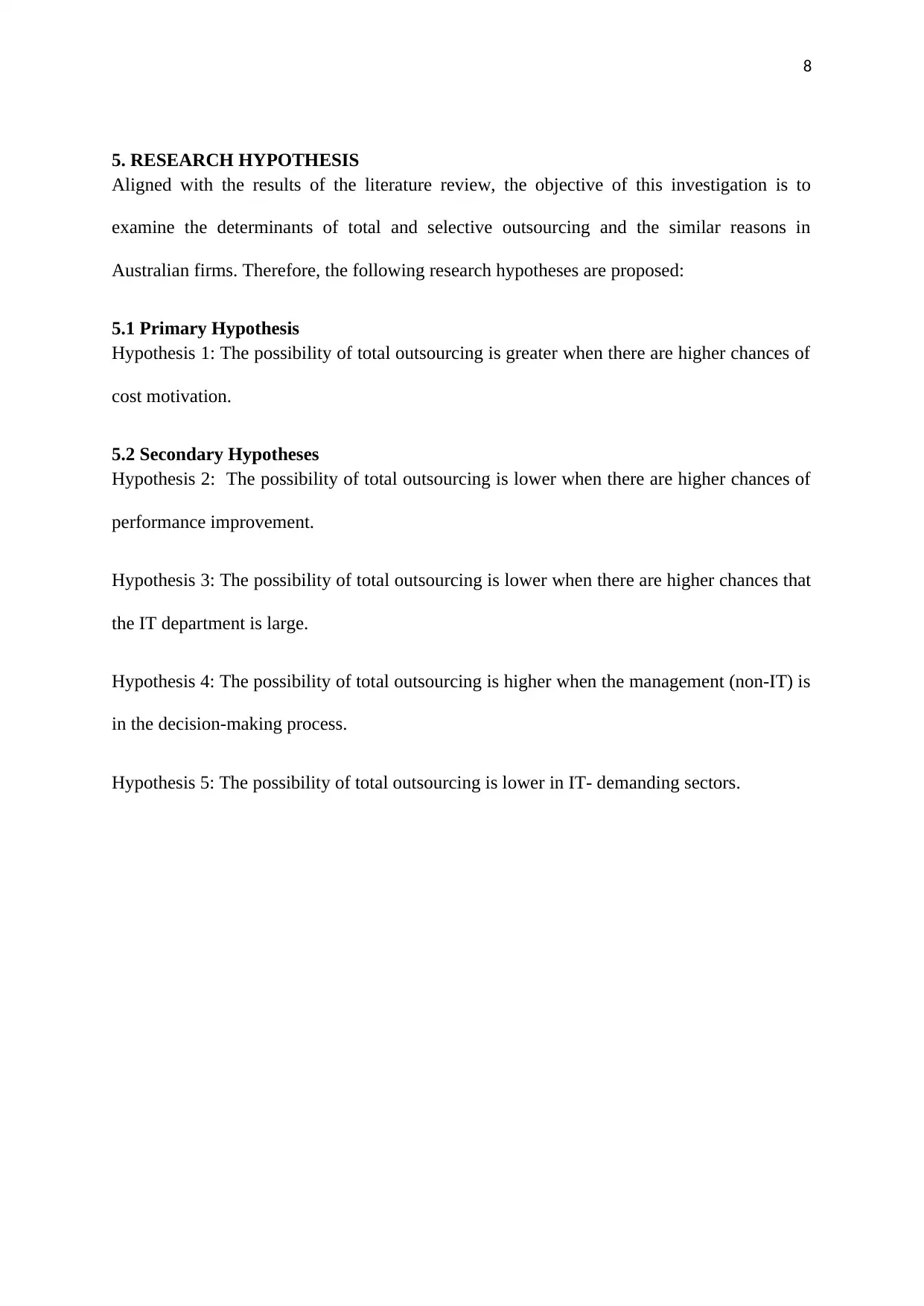
8
5. RESEARCH HYPOTHESIS
Aligned with the results of the literature review, the objective of this investigation is to
examine the determinants of total and selective outsourcing and the similar reasons in
Australian firms. Therefore, the following research hypotheses are proposed:
5.1 Primary Hypothesis
Hypothesis 1: The possibility of total outsourcing is greater when there are higher chances of
cost motivation.
5.2 Secondary Hypotheses
Hypothesis 2: The possibility of total outsourcing is lower when there are higher chances of
performance improvement.
Hypothesis 3: The possibility of total outsourcing is lower when there are higher chances that
the IT department is large.
Hypothesis 4: The possibility of total outsourcing is higher when the management (non-IT) is
in the decision-making process.
Hypothesis 5: The possibility of total outsourcing is lower in IT- demanding sectors.
5. RESEARCH HYPOTHESIS
Aligned with the results of the literature review, the objective of this investigation is to
examine the determinants of total and selective outsourcing and the similar reasons in
Australian firms. Therefore, the following research hypotheses are proposed:
5.1 Primary Hypothesis
Hypothesis 1: The possibility of total outsourcing is greater when there are higher chances of
cost motivation.
5.2 Secondary Hypotheses
Hypothesis 2: The possibility of total outsourcing is lower when there are higher chances of
performance improvement.
Hypothesis 3: The possibility of total outsourcing is lower when there are higher chances that
the IT department is large.
Hypothesis 4: The possibility of total outsourcing is higher when the management (non-IT) is
in the decision-making process.
Hypothesis 5: The possibility of total outsourcing is lower in IT- demanding sectors.
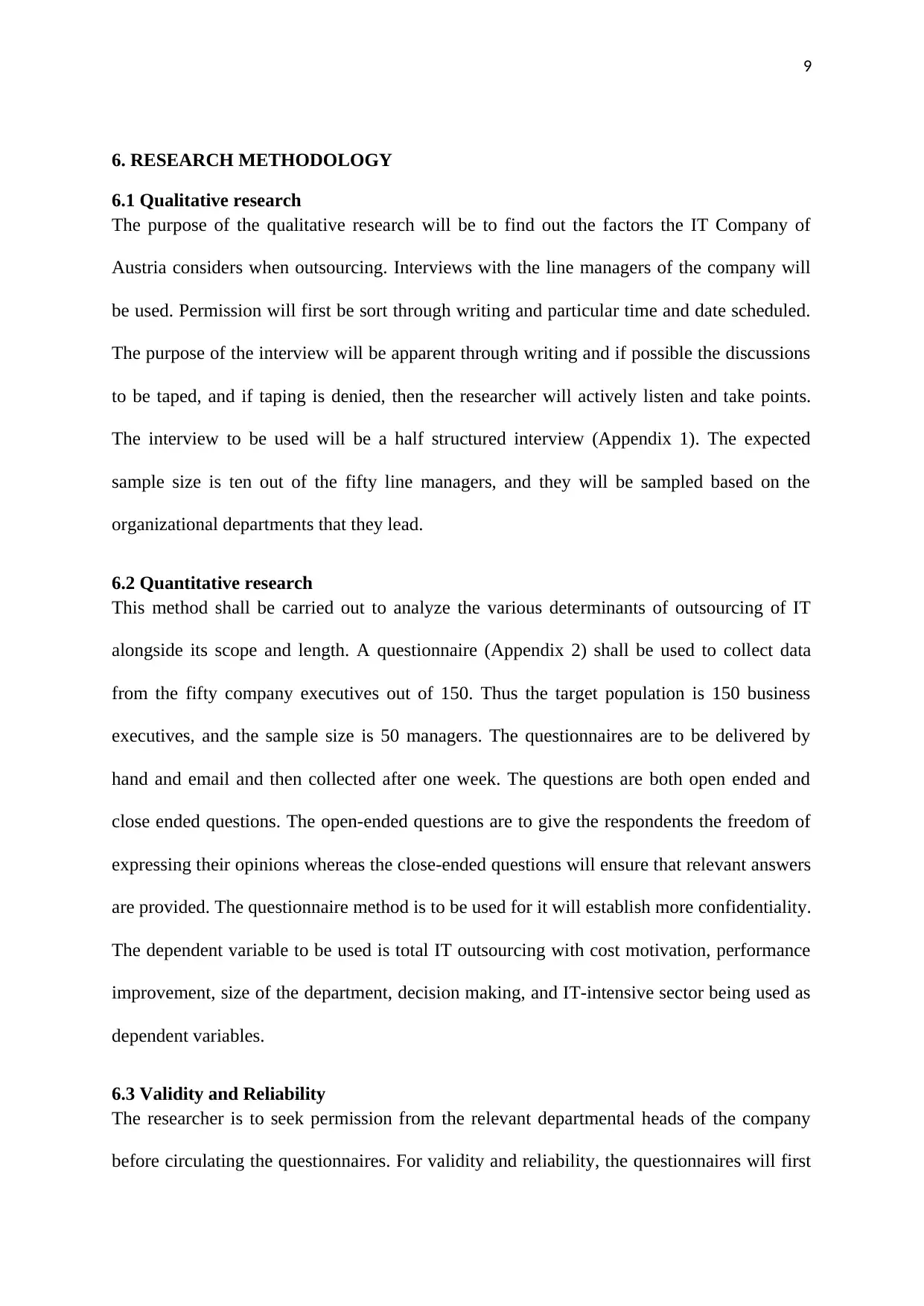
9
6. RESEARCH METHODOLOGY
6.1 Qualitative research
The purpose of the qualitative research will be to find out the factors the IT Company of
Austria considers when outsourcing. Interviews with the line managers of the company will
be used. Permission will first be sort through writing and particular time and date scheduled.
The purpose of the interview will be apparent through writing and if possible the discussions
to be taped, and if taping is denied, then the researcher will actively listen and take points.
The interview to be used will be a half structured interview (Appendix 1). The expected
sample size is ten out of the fifty line managers, and they will be sampled based on the
organizational departments that they lead.
6.2 Quantitative research
This method shall be carried out to analyze the various determinants of outsourcing of IT
alongside its scope and length. A questionnaire (Appendix 2) shall be used to collect data
from the fifty company executives out of 150. Thus the target population is 150 business
executives, and the sample size is 50 managers. The questionnaires are to be delivered by
hand and email and then collected after one week. The questions are both open ended and
close ended questions. The open-ended questions are to give the respondents the freedom of
expressing their opinions whereas the close-ended questions will ensure that relevant answers
are provided. The questionnaire method is to be used for it will establish more confidentiality.
The dependent variable to be used is total IT outsourcing with cost motivation, performance
improvement, size of the department, decision making, and IT-intensive sector being used as
dependent variables.
6.3 Validity and Reliability
The researcher is to seek permission from the relevant departmental heads of the company
before circulating the questionnaires. For validity and reliability, the questionnaires will first
6. RESEARCH METHODOLOGY
6.1 Qualitative research
The purpose of the qualitative research will be to find out the factors the IT Company of
Austria considers when outsourcing. Interviews with the line managers of the company will
be used. Permission will first be sort through writing and particular time and date scheduled.
The purpose of the interview will be apparent through writing and if possible the discussions
to be taped, and if taping is denied, then the researcher will actively listen and take points.
The interview to be used will be a half structured interview (Appendix 1). The expected
sample size is ten out of the fifty line managers, and they will be sampled based on the
organizational departments that they lead.
6.2 Quantitative research
This method shall be carried out to analyze the various determinants of outsourcing of IT
alongside its scope and length. A questionnaire (Appendix 2) shall be used to collect data
from the fifty company executives out of 150. Thus the target population is 150 business
executives, and the sample size is 50 managers. The questionnaires are to be delivered by
hand and email and then collected after one week. The questions are both open ended and
close ended questions. The open-ended questions are to give the respondents the freedom of
expressing their opinions whereas the close-ended questions will ensure that relevant answers
are provided. The questionnaire method is to be used for it will establish more confidentiality.
The dependent variable to be used is total IT outsourcing with cost motivation, performance
improvement, size of the department, decision making, and IT-intensive sector being used as
dependent variables.
6.3 Validity and Reliability
The researcher is to seek permission from the relevant departmental heads of the company
before circulating the questionnaires. For validity and reliability, the questionnaires will first
⊘ This is a preview!⊘
Do you want full access?
Subscribe today to unlock all pages.

Trusted by 1+ million students worldwide
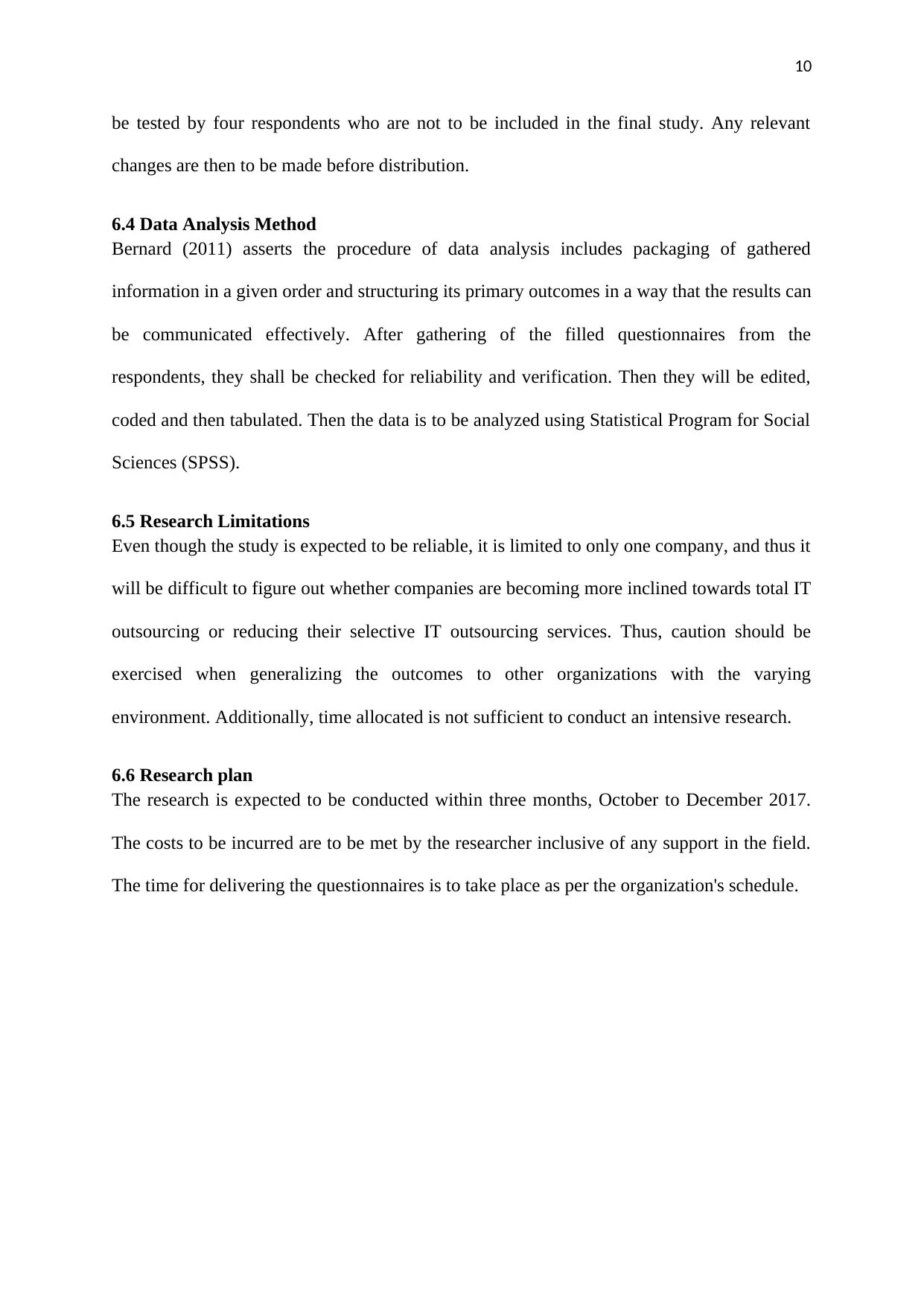
10
be tested by four respondents who are not to be included in the final study. Any relevant
changes are then to be made before distribution.
6.4 Data Analysis Method
Bernard (2011) asserts the procedure of data analysis includes packaging of gathered
information in a given order and structuring its primary outcomes in a way that the results can
be communicated effectively. After gathering of the filled questionnaires from the
respondents, they shall be checked for reliability and verification. Then they will be edited,
coded and then tabulated. Then the data is to be analyzed using Statistical Program for Social
Sciences (SPSS).
6.5 Research Limitations
Even though the study is expected to be reliable, it is limited to only one company, and thus it
will be difficult to figure out whether companies are becoming more inclined towards total IT
outsourcing or reducing their selective IT outsourcing services. Thus, caution should be
exercised when generalizing the outcomes to other organizations with the varying
environment. Additionally, time allocated is not sufficient to conduct an intensive research.
6.6 Research plan
The research is expected to be conducted within three months, October to December 2017.
The costs to be incurred are to be met by the researcher inclusive of any support in the field.
The time for delivering the questionnaires is to take place as per the organization's schedule.
be tested by four respondents who are not to be included in the final study. Any relevant
changes are then to be made before distribution.
6.4 Data Analysis Method
Bernard (2011) asserts the procedure of data analysis includes packaging of gathered
information in a given order and structuring its primary outcomes in a way that the results can
be communicated effectively. After gathering of the filled questionnaires from the
respondents, they shall be checked for reliability and verification. Then they will be edited,
coded and then tabulated. Then the data is to be analyzed using Statistical Program for Social
Sciences (SPSS).
6.5 Research Limitations
Even though the study is expected to be reliable, it is limited to only one company, and thus it
will be difficult to figure out whether companies are becoming more inclined towards total IT
outsourcing or reducing their selective IT outsourcing services. Thus, caution should be
exercised when generalizing the outcomes to other organizations with the varying
environment. Additionally, time allocated is not sufficient to conduct an intensive research.
6.6 Research plan
The research is expected to be conducted within three months, October to December 2017.
The costs to be incurred are to be met by the researcher inclusive of any support in the field.
The time for delivering the questionnaires is to take place as per the organization's schedule.
Paraphrase This Document
Need a fresh take? Get an instant paraphrase of this document with our AI Paraphraser
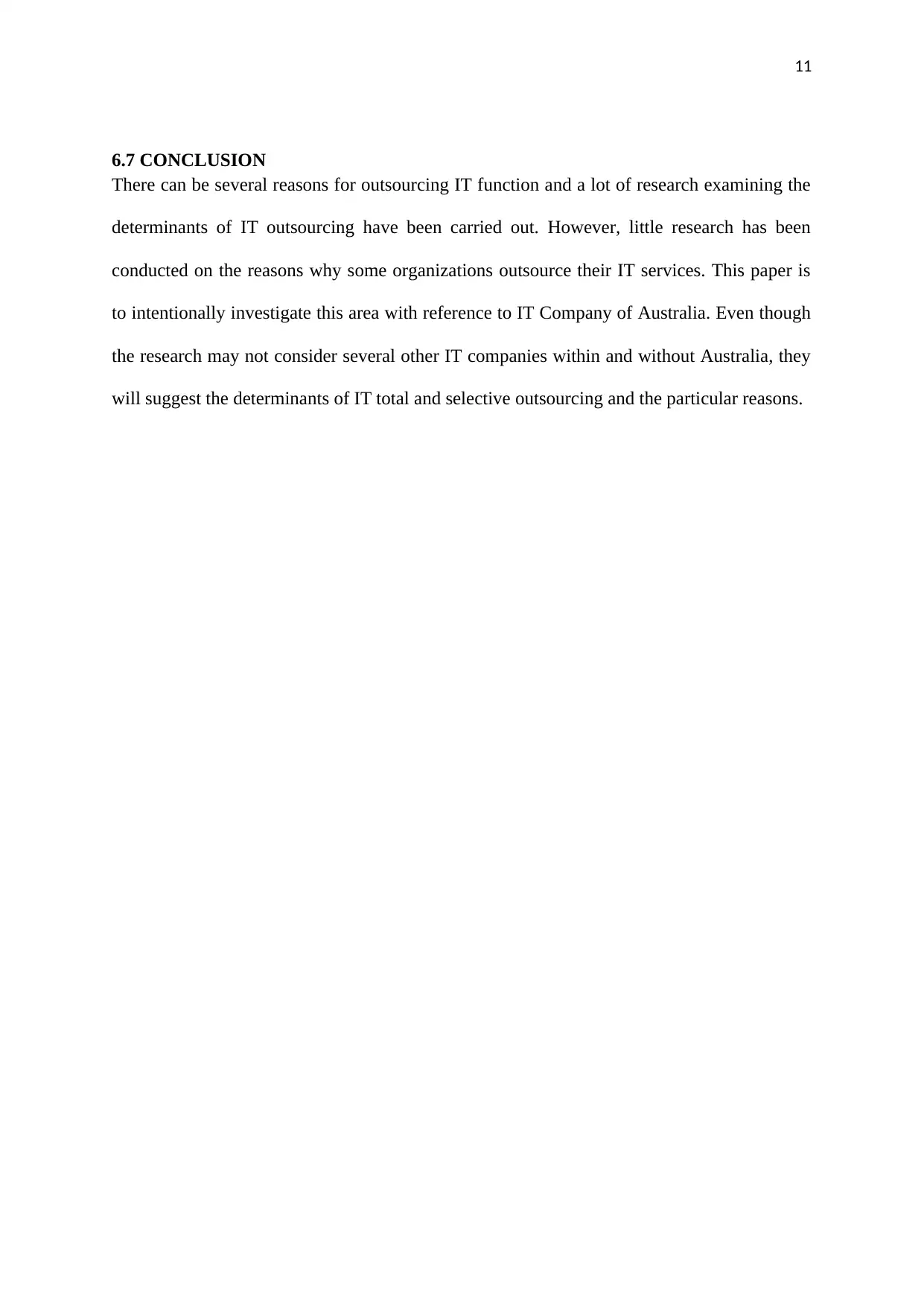
11
6.7 CONCLUSION
There can be several reasons for outsourcing IT function and a lot of research examining the
determinants of IT outsourcing have been carried out. However, little research has been
conducted on the reasons why some organizations outsource their IT services. This paper is
to intentionally investigate this area with reference to IT Company of Australia. Even though
the research may not consider several other IT companies within and without Australia, they
will suggest the determinants of IT total and selective outsourcing and the particular reasons.
6.7 CONCLUSION
There can be several reasons for outsourcing IT function and a lot of research examining the
determinants of IT outsourcing have been carried out. However, little research has been
conducted on the reasons why some organizations outsource their IT services. This paper is
to intentionally investigate this area with reference to IT Company of Australia. Even though
the research may not consider several other IT companies within and without Australia, they
will suggest the determinants of IT total and selective outsourcing and the particular reasons.
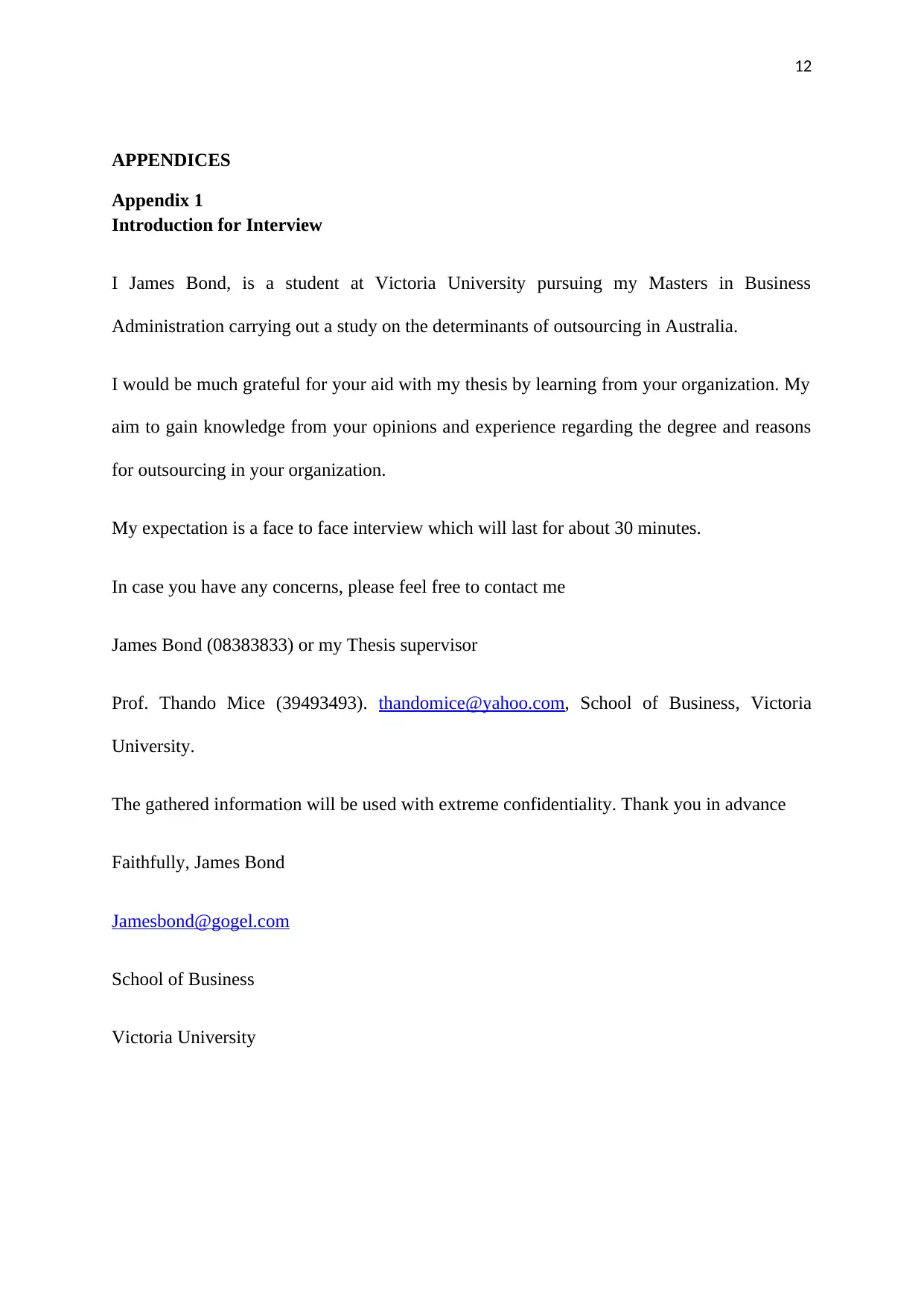
12
APPENDICES
Appendix 1
Introduction for Interview
I James Bond, is a student at Victoria University pursuing my Masters in Business
Administration carrying out a study on the determinants of outsourcing in Australia.
I would be much grateful for your aid with my thesis by learning from your organization. My
aim to gain knowledge from your opinions and experience regarding the degree and reasons
for outsourcing in your organization.
My expectation is a face to face interview which will last for about 30 minutes.
In case you have any concerns, please feel free to contact me
James Bond (08383833) or my Thesis supervisor
Prof. Thando Mice (39493493). thandomice@yahoo.com, School of Business, Victoria
University.
The gathered information will be used with extreme confidentiality. Thank you in advance
Faithfully, James Bond
Jamesbond@gogel.com
School of Business
Victoria University
APPENDICES
Appendix 1
Introduction for Interview
I James Bond, is a student at Victoria University pursuing my Masters in Business
Administration carrying out a study on the determinants of outsourcing in Australia.
I would be much grateful for your aid with my thesis by learning from your organization. My
aim to gain knowledge from your opinions and experience regarding the degree and reasons
for outsourcing in your organization.
My expectation is a face to face interview which will last for about 30 minutes.
In case you have any concerns, please feel free to contact me
James Bond (08383833) or my Thesis supervisor
Prof. Thando Mice (39493493). thandomice@yahoo.com, School of Business, Victoria
University.
The gathered information will be used with extreme confidentiality. Thank you in advance
Faithfully, James Bond
Jamesbond@gogel.com
School of Business
Victoria University
⊘ This is a preview!⊘
Do you want full access?
Subscribe today to unlock all pages.

Trusted by 1+ million students worldwide
1 out of 17
Related Documents
Your All-in-One AI-Powered Toolkit for Academic Success.
+13062052269
info@desklib.com
Available 24*7 on WhatsApp / Email
![[object Object]](/_next/static/media/star-bottom.7253800d.svg)
Unlock your academic potential
Copyright © 2020–2025 A2Z Services. All Rights Reserved. Developed and managed by ZUCOL.





